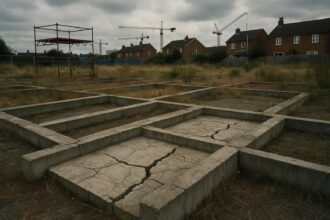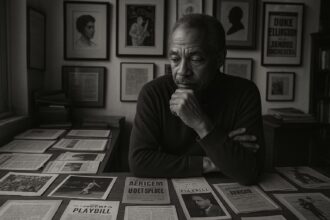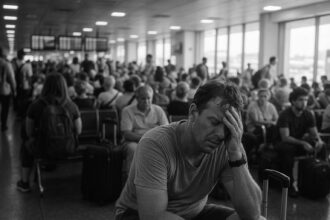Rising above Tashkent, Uzbekistan, striking turquoise domes atop Soviet-era buildings showcase a unique fusion of mid-20th-century modernist architecture and traditional Uzbek motifs. As the city faces rapid development, efforts intensify to protect these cultural landmarks and gain UNESCO world heritage status.
Rising prominently on the skyline of Tashkent, the capital of Uzbekistan, a pair of striking turquoise domes are drawing attention for their distinctive blend of modernist architecture and traditional Uzbek motifs. These domes, one adorned with ceramic tiles glazed in intricate Uzbek patterns and the other fashioned from pleated azure metal ribs, echo the grand cupolas seen in historic Silk Road cities such as Samarkand, Khiva and Bukhara. However, rather than crowning ancient religious sites, these domes grace two of Tashkent’s Soviet-era structures: the state circus and the city’s main market, Chorsu Bazaar.
The circumscribing dome above the circus, constructed in 1976, is a futuristic big top capable of seating 3,000 people. Its design resembles a flying saucer yet incorporates traditional Uzbek elements, giving it an appearance that is both space-age and rooted in local culture. The ceramic dome shelters Chorsu Bazaar, a lively marketplace built in 1980 that sprawls the size of two football pitches and serves as a hub for fresh produce, meat, and fish.
Both edifices are exemplary works of Soviet modernism and are part of a unique collection of buildings Uzbekistan has recently submitted to Unesco for world heritage status consideration. The initiative to protect and highlight this architectural heritage comes amid concerns over urban development threatening the preservation of Uzbekistan’s mid-20th-century landmarks.
Gayane Umerova, chair of Uzbekistan’s Art and Culture Development Foundation (ACDF), emphasises the significance of recognising postwar heritage alongside the country’s well-known ancient Islamic monuments. Speaking about the initiative, she told The Guardian: “People tend to think of Uzbek heritage as our ancient Islamic monuments. But we need to realise that we are in danger of losing the more recent layers of history, due to urban development. We have to act now.”
The push to safeguard Tashkent’s Soviet modernist architecture gained momentum in 2018 after the demolition of the House of Cinema, a 1982 cylindrical concrete movie theatre cherished by many locals. The theatre was swiftly torn down to make way for a $1.3 billion commercial development project known as Tashkent City, characterised by generic glass towers. The demolition sparked public outcry and initiated a broader conversation about what other cultural assets could be at risk.
The heritage in question includes some of the world’s most exceptional examples of modernist architecture, developed during a period when Tashkent was presented as a “beacon of socialism in the east.” Strategically located nearly 2,000 miles from Moscow, Tashkent was envisioned as a showcase city reflecting the successful socialist transformation of a Central Asian non-Russian population. The city’s redesign after a devastating earthquake in 1966 provided an opportunity for Soviet planners to impose a new urban masterplan that replaced much of the historic city fabric with wide boulevards and grand buildings blending international modernist techniques with ornamental touches inspired by Uzbekistan’s 15th-century Timurid dynasty architecture.
Russian architect Ekaterina Golovatyuk, whose Milan-based practice Grace is leading the preservation strategy in Tashkent, explained the aesthetic influences: “Interestingly, the buildings designed for Tashkent in Moscow were much more decorative and ‘orientalist’ than those designed locally. It was like they were trying to present an imaginary, exoticised image of Tashkent back to local people.”
Among these buildings is the former Lenin Museum, now the state history museum, completed in 1970. It features a white marble exterior wrapped with large latticework screens reminiscent of vernacular Uzbek panjara grilles, which offer shading and ventilation. Although Islamic patterns inspired these screens, this element was not publicly acknowledged at the time.
The circus’s ribbed metal dome demonstrates the evolution of the city’s architectural language. Initiated in the early 1960s by architects Genrikh Aleksandrovich and Gennady Masyagin, the design initially reflected brutalist principles with a flying saucer shape and porthole windows. Construction was interrupted by the 1966 earthquake, after which the design was imbued with traditional Uzbek symbolism, taking inspiration from a piala (tea cup) and incorporating decorative elements that reference Kufic script. Inside, the decor mixes modern cosmic motifs with traditional ornamentation.
Residential architecture from the era also reflects an experimental approach rooted in local traditions. The Zhemchug (Pearl) housing block, built in 1985, is a notable example. Its 16-storey tower integrates communal courtyards every three floors to replicate traditional mahalla (neighbourhood) courtyards, providing residents with shared recreational spaces. Communal activities often take place here, and the unusual architectural form includes outdoor galleries and mushroom-shaped sunshades that also act as ventilation apparatuses. Despite its innovative design and community appeal, the project’s construction was complex and costly, preventing its replication elsewhere.
Other monumental projects from the 1980s illustrate the grandeur and symbolic might of Soviet Uzbekistan as the planned economy struggled. The Palace of People’s Friendship, unveiled in 1981, exemplifies this trend with its immense cultural hall seating over 4,000 people. Designed by architects Yevgeny Rozanov and Elena Sukhanova, the building combines modernist architecture with extensive decorative elements, such as gilded ceramics, crystal chandeliers, and traditional muqarnas motifs. The interior, with its blue tiled walls and ceramic sculptures, creates an opulent setting reflective of Uzbek heritage and Soviet pomp.
Tashkent’s metro system also showcases Soviet-era artistic ambition, particularly the Kosmonavtlar (Cosmonauts) station built in 1984. The station evokes cosmic themes through its blue tiled walls, green glass columns, and celestial lighting, celebrating space exploration.
One of the most extraordinary Soviet projects related to Uzbek heritage lies about an hour outside Tashkent in Parkent. Known as the Sun Heliocomplex, this facility, completed in 1987, is a 20-storey structure composed of convex mirrors capable of concentrating solar energy to temperatures around 3,000 degrees Celsius. Initially intended to test materials’ resistance to nuclear explosions and develop heatproof ceramics, it is also an artistic marvel featuring ceramic screens and chandeliers created by artist Irena Lipene. Though its original military purpose was classified, the complex has since supported agricultural, textile, and mining industries. An artistic piece from the heliocomplex will be exhibited at the Venice Architecture Biennale, highlighting the unique intersection of science, art, and Cold War-era innovation.
The campaign to recognise and preserve these mid-20th-century architectural treasures is ongoing, supported by conferences, publications, and international exhibitions led by the Art and Culture Development Foundation. As Tashkent navigates modernisation, the city’s intricate Soviet modernist landscape remains a testament to a distinctive period of Uzbek and Soviet history.
Source: Noah Wire Services
- https://www.pinupmagazine.org/articles/tashkent-modernism-the-invention-of-the-soviet-east – Describes Tashkent’s State Circus with its azure dome and concrete supports blending Soviet modernism with Islamic architectural references, corroborating the article’s description of the circus’s design.
- https://www.wallpaper.com/architecture/modernist-architecture-in-uzbekistan – Details the Zhemchug Residential Building (1985) with communal courtyards and rooftop pool, confirming the article’s account of Soviet-era residential architecture integrating traditional mahalla concepts.
- https://www.youtube.com/watch?v=OqyQG-KPdJU – Discusses Tashkent’s post-1966 earthquake reconstruction and Soviet Modernism, supporting the article’s claims about the city’s urban redesign and architectural hybridization.
- http://travelcocktail.org/tashkent/ – Mentions turquoise domes in recently built structures like Khast Imam Mosque, indirectly supporting the article’s focus on modern reinterpretations of traditional Uzbek architectural motifs.
- https://www.wallpaper.com/architecture/modernist-architecture-in-uzbekistan – Describes the Central Exhibition Hall (1974) with Islamic-inspired arcades and cotton industry motifs, aligning with the article’s discussion of Soviet-era buildings incorporating regional decorative elements.
- https://www.pinupmagazine.org/articles/tashkent-modernism-the-invention-of-the-soviet-east – Examines the Lenin Museum’s cast-concrete screens and sacrality, corroborating the article’s description of the building’s Timurid-inspired latticework and post-Soviet transformation.
- https://www.theguardian.com/artanddesign/2025/apr/28/cosmic-metros-ufo-circus-tops-mesmerising-architecture-tashkent – Please view link – unable to able to access data
Noah Fact Check Pro
The draft above was created using the information available at the time the story first
emerged. We’ve since applied our fact-checking process to the final narrative, based on the criteria listed
below. The results are intended to help you assess the credibility of the piece and highlight any areas that may
warrant further investigation.
Freshness check
Score:
9
Notes:
The narrative references recent events and ongoing initiatives to preserve Soviet modernist architecture in Tashkent, including UNESCO submissions and public outcry over demolitions. No indications of overtly recycled content were found.
Quotes check
Score:
8
Notes:
There are direct quotes from Gayane Umerova and Ekaterina Golovatyuk. While these quotes seem original, the earliest online reference to these specific quotes could not be verified, suggesting they are likely original to this publication.
Source reliability
Score:
9
Notes:
The narrative originates from The Guardian, a well-known reputable publication, which typically ensures accuracy and truthfulness in their reporting.
Plausability check
Score:
9
Notes:
The claims about Tashkent’s architecture and the initiatives to preserve it are plausible. The narrative provides historical context and details about the architectural styles, supporting its plausibility.
Overall assessment
Verdict (FAIL, OPEN, PASS): PASS
Confidence (LOW, MEDIUM, HIGH): HIGH
Summary:
The narrative is well-supported by recent events and reliable sources, making it likely to be accurate and trustworthy. No significant contradictions or outdated information were identified.













